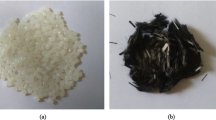Abstract
A new design methodology is developed to mold the polymer spur gears with high strength fiber reinforcement only in the highly stressed region. High performance high cost short carbon fiber reinforced Nylon 66 is used in the highly stressed tooth region and low cost unreinforced Nylon 66 is used in the hub region. Two different geometries, circular and spline shaped hubs were used for developing the selective reinforced gears by multi-shot injection-molding process. Joint strength of the selectively reinforced gear was estimated using shear tests. Clear hub and tooth region separation without any distortion was observed in joint shear tests. A molten material due to fusion bonding was observed at the interfaces. The joint strength was also evaluated by conducting gear fatigue tests using a power absorption test rig at various torque levels and at a constant gear rotational speed. Monolithic reinforced gear and selective reinforced gears with spline hub exhibited similar fatigue behavior. The failure mode depends upon the test torque level. The selective reinforced gears with circular hub showed joint failures at high-test torque levels. Absence of mechanical interlocking feature in the circular hub geometry contributes to the joint failure. Thermal bond, part interference and mechanical interlocking feature provide sufficient joint strength to the selective reinforced gear with spline hub.
Similar content being viewed by others
References
Ageorges, C. and Ye, L., ‘Resistance Welding of Thermosetting Composites/Thermoplastic Composite Joints’, Composites Part A 32, 2001, 1603–1612.
Grimm, R. A., ‘Fusion Welding Techniques for Plastics’, Welding Journal 69, 1990, 23–28.
Schwartz, M. M., Joining of Composite Materials, Ohio; ASM International Materials Park, 1994.
Corten, H. T., ‘Reinforced Plastics’, in Engineering Design for Plastics, E. Baer (ed.), SPE Polymer Science and Engineering Series, Reinhold Publishing Corporation, New York, 1964, pp. 869–881.
Maitra, G. M., Handbook of Gear Design, Tata McGraw-Hill, New Delhi, 1994.
Gramann, P. J., Osswald, T. A. and Turng, T., Injection Molding Handbook, Hanser Gardner Publications, Cincinnati, 2001.
Schuller, T. and Lauke, B., ‘Measuring the Interfacial Transverse Strength: A Novel Test for Evaluating Polymer Joints’, International Journal of Adhesion and Adhesives 22, 2002, 169–174.
Ageorges, C., Ye, L. and Hou, M., ‘Advances in Fusion Bonding Techniques for Joining Thermoplastic Matrix Composites: A Review’, Composites Part A 32, 2002, 839–857.
Kurokawa, M., Uchiyama, Y., Iwai, T. and Nagai, S., ‘Performance of Plastic Gear Made of Carbon Fiber Reinforced Polyamide 12’, Wear 254, 2003, 468–473.
Wright, N. A. and Kukureka, S. N., ‘Wear Testing and Measurement Techniques for Polymer Composite Gear’, Wear 250, 2001, 1567–1578.
Walton, D., Croppe, A. B., Weale, D. J. and Klein Meuleman. P., ‘The Efficiency and Friction of Plastic Cylindrical Gears: Part 1 – Influence of Materials’, Proceedings of the Institution of Mechanical Engineers, Part J, Journal of Engineering Tribology 216, 2002, 75–92.
Product Data Sheet of RTP 200, and 283, Grade of RTP Company Engineering Thermoplastic Composites, Winona MN, 2004.
DIN 3962 Pt 1–3, Tolerances of Cylindrical Gear Teeth – Tolerances for Deviations of Individual Parameters, Tolerances for Tooth Trace Deviations, Tolerances for Pitch Span Deviations, Berlin, 1994
Dominick, V. R., Donald, V. R. and Marlene, G. R., Plastics Design Handbook, Kluwer, Dordrecht, 2000.
LNP Literature, A Guide to Plastic Gearing, LNP Engineering Plastics, Exton, Pa, 2004.
Dudley, D. W., ‘When Splines Need Stress Control’, Product Engineering 28, 1957, 56–59.
ANSI B92.2M-1980, Specification for 30 0 Full Fillet Side Fit Involute Splines, American National Standards Institute, New York, 1980.
Clegg, D. W. and Collyer, A. A., Mechanical Properties of Reinforced Thermoplastics, Elsevier Applied Science, London, 1986.
Senthilvelan, S. and Gnanamoorthy, R., ‘Condition Monitoring and Failure Analysis of Composite Gear’, Proceedings of the 11 th National Conference of Machines and Mechanisms, New Delhi, 2003, 278–82.
Walton, D., Tessema, A. A. and Shippen, J. M., ‘A Note on Tip Relief and Backlash Allowance in Non-metallic Gears’, Proceedings of the Institution of Mechanical Engineerrs, Part C, J of Mechanical Engineering, Science 208 (C2), 1994, 81–87.
Senthilvelan, S. and Gnanamoorthy, R., ‘Damage Mechanisms in Injection Molded Unreinforced, Glass and Carbon Reinforced Nylon 66 Spur Gears’, Applied Composite Materials 11(6), 2004, 377–397.
Author information
Authors and Affiliations
Corresponding author
Rights and permissions
About this article
Cite this article
Senthilvelan, S., Gnanamoorthy, R. Selective Carbon Fiber Reinforced Nylon 66 Spur Gears: Development and Performance. Appl Compos Mater 13, 43–56 (2006). https://doi.org/10.1007/s10443-005-9003-6
Received:
Accepted:
Published:
Issue Date:
DOI: https://doi.org/10.1007/s10443-005-9003-6




